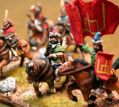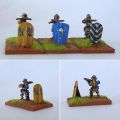Later Russian
Historical Overview Section
1265-1500
The Russians in this list were the successors to the Kievan Rus and inherited the troubled situation the disintegration of the Rus state had created through years of in-fighting between members of the royal family. As Kiev's dominance waned, Vladimir-Suzdal rose in the north-east, Novgorod in the north, and Halych-Volhynia in the south-west. However none of these small states were able to do much to resist the Tatar invasions which reduced every state save for Novogorod to vassal status.
The impact of the Mongol invasion on Later Russian territory was uneven, with mant former Rus cities being almost completely destroyed, including older centers such as Kiev and Vladimir. They never recovered from the devastation of the initial attacks, allowing new cities of Moscow, Tver and Nizhny Novgorod to emerge as centers of power. The Mongols were not active rulers of Russia, and both Russia and the Later Bulgarian state were ruled remotely from their Western Tatar capital at Sarai, one of the largest cities of the medieval world. The princes of southern and eastern Russia had to pay tribute to the Mongols of the Golden Horde, but in return they received charters authorizing them to act as deputies to the khans and the fledgling Russian princes were allowed considerable freedom to rule as they wished. The Russian Orthodox Church even experienced a spiritual revival in this period, which contributed to a perception that the fanatical Later Teutonic Knights might prove to be a greater threat to the Russian way of life than the Mongols.
In the mid-13th century, Alexander Nevsky, elected prince of Novgorod, acquired heroic status as the result of major victories over the Later Teutonic Knights and the Post-Viking Scandinavian armies. Nevsky was the fourth son of Russian prince Yaroslav Vsevolodovich and so at birth seemed to have no chance of claiming the throne of Vladimir. In 1236, however, he was summoned by the Novgorodians to become kniaz' (or prince) of Novgorod and, as their military leader, to defend their northwest lands from Swedish and German invaders. After the Swedish army had landed at the confluence of the rivers Izhora and Neva, Alexander and his small army suddenly attacked them at Neva on July 15, 1240 and defeated them, saving the country from a full-scale invasion from across the Baltic. The 19-year-old Alexander was given the name of "Nevsky" (which means of Neva). After Pskov had been invaded by the crusading Later Teutonic Knights of the brotherhood of Livonian Knights, the Novgorod authorities sent for Alexander again and in spring of 1241 he returned from his exile, gathered an army, and drove out the invaders on the ice of the Lake Peipus and defeated them in what became known as the Battle of the Ice on April 5, 1242.
Alexander’s victory was a significant event in the history of the Middle Ages as foot soldiers of Novgorod had surrounded and defeated an army of knights, mounted on horseback and clad in thick armor long before Western Europeans learned how foot soldiers could prevail over mounted knights. Nevsky's great victory against the Livonian Brothers may well have also been an early example of spin doctoring, as only a few knights were actually killed rather than hundreds claimed by the Russian chroniclers, however the victory was an important milestone in the emergence of the Muscovites as the dominant faction in Russia.
Alexander achieved many of his victories with the aid of Tatar forces, but when Daniil Aleksandrovich, the youngest son of Nevsky, founded the principality of Moscow he laid the foundations of a state which eventually expelled the Tatars from Russia. Moscow originally was a vassal of the larger state of Vladimir, but soon it absorbed its parent state thanks in no small part to a close cooperation of its rulers with the Tatar overlords, who made them agents for collecting the Tatar tribute from the Russian principalities. The principality's prestige was further enhanced when it became the center of the Russian Orthodox Church. By the middle of the 14th century, the power of the Tatar Mongols was declining, and the Grand Princes of Moscow were able to openly oppose the Mongol yoke. In 1380, at Kulikovo on the Don River, the Mongols were defeated and although this hard-fought victory did not end Tatar rule of Russia, it did was a big step in the right direction as far as the Russians were concerned. Moscow's leadership in Russia was now firmly based and by the middle of the fourteenth century its territory had greatly expanded through purchase, war, and marriage.
In the 15th century, the grand princes of Moscow went on gathering Russian lands to increase the population and wealth under their rule. The most successful practitioner of this process was Ivan III who laid the foundations for a Russian national state. Ivan competed with his powerful northwestern rival, the Later Lithuanian Grand Duchy of Lithuania for control over the upper Dnieper and Oka River basins. In 1480 Ivan refused to pay the customary tribute to the grand Khan Ahmed. When, however, the grand khan marched against him, Ivan's courage began to fail, and only the stern exhortations of the high-spirited bishop of Rostov, Vassian, could induce him to take the field. All through the autumn the Russian and Tatar hosts confronted each other on opposite sides of the Ugra, till the 11th of November, when Ahmed retired into the steppe. In the following year the grand khan, while preparing a second expedition against Moscow, was suddenly attacked, routed and slain by Ivak, the khan of the Nogay Horde, where upon the Golden Horde suddenly fell to pieces! In 1487 Ivan reduced the khanate of Kazan one of the offshoots of the Horde to the condition of a vassal-state, though in his later years it broke away from his suzerainty. With the other Muslim powers, the khan of the Crimean Khanate and the sultans of Ottoman Empire, Ivan's relations were pacific and even amicable. The Crimean khan, Meñli I Giray, helped him against the Grand Duchy of Lithuania and facilitated the opening of diplomatic intercourse between Moscow and the Later Ottoman Empire in Istanbul, where the first Russian embassy appeared in 1495.
Using the army in FoG
- For all the interesting history, this is a Bw/Sw outfit, with a rather unappealing uption to take a lot of the cavalry as Average. They are also undrilled, which can lead to a problem in attempting to shift to skirmish formation from 2 ranks deep.
- The foot are generally too few in number to be of much use although a handgunner unit can help with mounted shooting, and a cheap Bw unit can give LH enemies a nasty shock on a flank.
UK Tournament Results with this army
Useful Links
User-contributed links about this army:
- Flags to download from AlexFlags
- Nevsky History on medieval Lands.com
- Alexander Nevsky, Sergei Eisenstein's landmark tale of Russia thwarting the German invasion of the 13th century, was wildly popular with home-grown audiences back in 1938, quite intentionally so, given the prevailing Nazi geopolitical advancement and destruction at the time. It can still be viewed as a masterful use of imagery and music, with the "Battle on the Ice" sequence as the obvious highlight. Buy the Film Alexander Nevsky from Amazon.co.uk
- Fanaticus banner download page with some banners that can be used for this army
Allies
- Later Lithuanian - better quality LH than the few allowed in this army, but it may be best to stick with your own Tatars and have a few more Bw/Sw Cv to chase off enemy skirmishers
- Tatar Golden Horde - Use to have Bw/Sw LH of any flavour in numbers of up to 18
15mm Manufacturers supplying figures for this army
Many manufacturers have generic Medieval and East European ranges - those noted have specific (or particularly good) relevant figres
You can see some of the figures in the Ancients Photo Gallery also on this site

|

|

|

|

|
- Essex Miniatures - Several East European Medieval ranges
- Donnington C13-5 East Europe Ranges
- Vexilia - v good East European ranges
- Museum Miniatures East Europeans
- Gladiator Miniatures by Fighting 15's (Previously Black Hat) - East European range
- Old Glory 15's, East European and Russian ranges
- fighting 15's - Uk supplier for Oddzial Ozmy's Polish-cast 1410 Tannenberg Teutonics, Polish & Lithuanians
- East Riding Miniatures
- Isarus - sold by 15mm.co.uk E. European Medieval range
- Viking Forge
- Irregular Miniatures 60 medievals in a range spanning East & West Europe from Late Feudal to C15
- Lancashire Games Around 30 generic & English medievals
- Tin Soldier 40 C14 & C15 medievals, including equipment
- Minifigs UK Some Russian cavalry from this period
- Camelot Games (Italy) Rus, and CXIII medievals
- Naismith & Roundway Russian Medieval range plus other nearby nations
- Fire & Sword System Crimean Tatars and Cossacks
Core Troops
Which troops are absolutely needed for this army, and what are your thoughts on how to organise, paint and buy them.
Army Lists
Sample army lists for this army
Name of Army / Date
- Using asterisks inthe edit mode creates a bulleted list in the actual site
- This is a lot easier to do than easier than setting up tables
- For FoG I suggest listing your army in order or march
- with troop desctiptions on each line, for example
- 4 HF Armoured Average Drilled Impact Foot Swordsmen
- 8 LG Undrilled Unarmoured Poor Bowen
- Dont forget to include your Generals !!!
Include any notes you want here, including comments on how to use - or play against - the army.
Remember to leave a line before you copy the above section as a template for your own list
eBay Listings
UK Bookstore